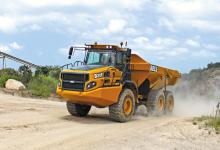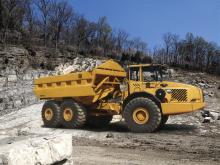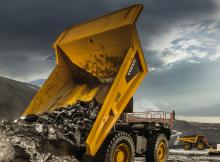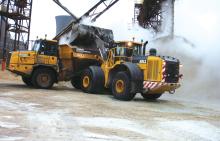
There are various ways in which to move overburden and quarried material from the digging face to the crusher, and from primaries to secondary and tertiary crushing and screening operations. For many, the rigid dump truck remains the machine of choice, a range of sizes capable of carrying anything from 25tonnes to many hundreds of tonnes efficiently and consistently is a persuasive argument.
However, the articulated dump truck (ADT) has become an increasingly popular option in smaller quarries, particularly those where it is difficult to guarantee good haul road conditions. Though primarily an earthmoving and muckshifting machine, the move to 40 and even 50tonne ADTs has seen them crossing over into quarry work.
Both truck types are competing for market space with a growing call for long distance conveyors, and for mobile crusher and moveable conveyor operations that literally put the primary crusher at the quarry face.
To compete, trucks have had to prove that they deliver on a cost per tonne basis, which means driving down fuel consumption and pushing up productivity. In Europe and North American markets engine emissions have been driving truck design, as increasingly stringent standards call for everlower output of particulates and exhaust gases such as oxides of nitrogen.
Though many markets in Africa, Asia and the Middle East are currently running at Tier 2 or Tier 3 emissions levels, they are benefitting from many of the efficiencies being found in more highly-regulated territories. They aren’t simply running older engine technology, while driveline components such as transmissions and axles are also constantly being improved.
Whichever emissions level you choose, the truck benefits from an electronically controlled driveline. It has torque-controlled gearshifts for improved steep grade climbing efficiency. Coming downhill it also gets assistance from an Automatic Retarder Control with optional engine braking, allowing higher haul speeds and improving operator comfort.
It’s a similar story with
Despite being regulated to Tier 2 levels, the trucks promise an 8% reduction in fuel consumption compared to previous models, though they deliver 10% more power and 22% more torque in the case of the DA40, and 8% more power with 30% more torque in the DA30.
Part of that fuel saving has come from the fitting of the latest ZF transmission, offering eight forward speeds with smooth Tiptronic gear-shifting.
The trucks also provide a wider speed range, increasing productivity on sites where it is possible to make use of those higher travel speeds.
Cat’s B Series ADTs offer similar gains. “The entire powertrain is based on an integrated systems design approach,” says product marketing supervisor Anthony Pollock.
“Caterpillar’s advanced productivity electronics controls strategy (APECS) software makes sure that the machine is in the correct gear to provide the best traction, lowest noise and highest fuel efficiency.” As with the majority of truck manufacturers,
The Russian market is also taking an increasing interest in the firm’s rigid haulers, with the 100tonne capacity TR100 in strong demand. Terex has established a joint venture in Russia to build trucks from kits, and the first machines are now being delivered from this facility. The firm also has an established JV in China, where Terex trucks have been produced for more than 20 years.
“We’re starting to see a lot of sales into the Middle East for the TR100,” says Terex global product manager Scott Pollock.
“The majority of our truck sales go to the mine and quarry industries and the Middle East is still a relatively untapped aggregates market.”
Mr Pollock reports that, as with more developed quarry markets, there is a growing requirement for increased payloads from many customers. Traditionally the firm’s 60tonne rigid has sold well in Indonesia, for example, but there is now a growing call to move up to the 100tonne TR100.
Established players such as Terex and Caterpillar do not have the market to themselves these days though.
The latest version of the firm’s HD785-7 is powered by a 1,178hp (878kW) engine that is equipped with variable horsepower control (VHPC).
This system sets the maximum engine power to one of four levels to match the job and the working conditions. The operator can choose between power or economy modes and the VHPC automatically detects if the truck is laden or empty.
With growing demand for 100tonne trucks, the EH1700-3 will probably be the most in demand. At a rated 95.2tonnes, the EH1700-3 is powered by a Tier 2
However the firm has been pushing into the ADT sector, initially with the 30tonne TA230. With that truck now accepted in a number of markets the company will this year launch the TA240, a 40tonne capacity ADT, at the bauma construction equipment show in Munich.
The TA240 will use a V8 Liebherr diesel engine producing 476hp (350kW) and the truck will offer travel speeds of up to 57km/h. A high performance retarder helps to bring things to a halt, while the truck uses spring and damper units on the front axle for a smoother ride.
There are a number of manufacturers concentrating purely on the ADT sector, with
South Africa’s
“We wanted to build on what we had achieved with our longstanding successful D Series, by simplifying the interface and making the cab more ergonomic where possible,” he says.
The E Series trucks have been in development for five years, undergoing durability testing. Bell says that the development process has involved an unprecedented amount of customer interaction, with a rigorous test schedule involving some of the harshest mine and quarry sites in the world.
When it comes to hauling rock, the rigid dump truck, and to a lesser extent the articulated hauler, remain strong favourites in quarries. While the pace of engine development, to meet stringent emissions standards, is pushing truck design in Europe, the US and Japan, the good news for less regulated territories is that many of the additional productivity and efficiency benefits that come with the latest engines, are also present with Tier 2 and Tier 3 power.









